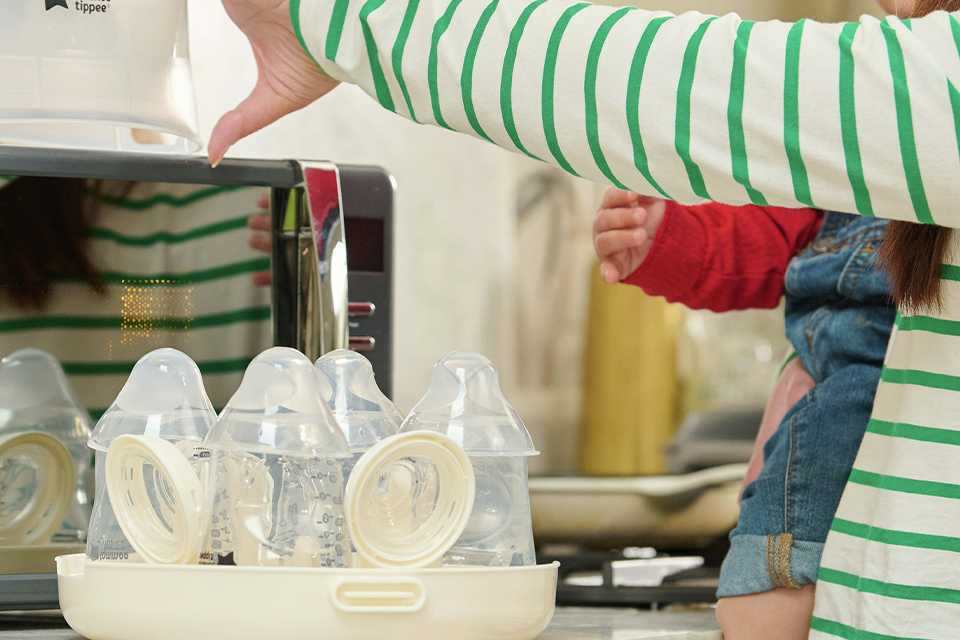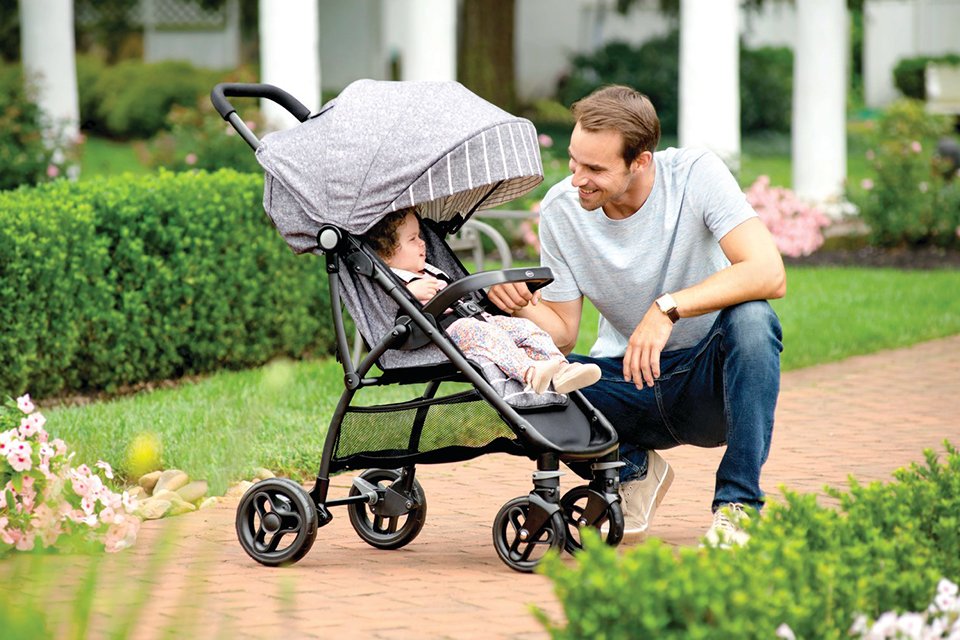Baby feeding and weaning
Advice on breastfeeding, bottle feeding and weaning for when they're ready to start solids.
Shop all baby feeding and weaning productsBreastfeeding essentials
Breast pumps
A breast pump allows you to collect your milk to be fed when you're not around, or when you're trying to sleep. Make sure you refrigerate it if you want to store it for up to 5 days.
Choose from manual or electric pumps. Manual pumps are best for occasional use, electric are better for regular pumping. Take a look at the silent Elvie wearable pumps for a really convenient (and silent) option.
Breastfeeding-friendly clothing
With some clever hidden feeding features, such as nursing layers and cut-out holes, Tu offers a range of maternity clothing that’s both pretty and practical. Helping to make nursing that little bit easier.
Burping baby
Once baby has had a feed, they’ll likely need to be burped, or winded. You can burp baby by putting them over your shoulder, or sitting them on your lap, and gently rubbing or patting their back, It’s useful to have a muslin square in case they bring any milk back up.
Breastfeeding accessories
Bottle feeding essentials
Preparing to bottle feed
- If you are unable to breastfeed, bottle feeding is still a good way to give the baby all the essential nutrients.
- To bottle feed, you'll need to have several bottles and teats ready for multiple feeds.
- Make sure to sterilise them before every use.
- To prepare the formula, carefully follow the instructions on the packaging.
- Any formula you make needs to be kept chilled and used within 24 hours.

How to bottle feed your baby
- First, make sure you're comfortable.
- Hold baby in your arms but raise their body to an upright position, supporting their head with your hand.
- Brush the bottle's teat against their lips, letting them draw it in when their mouth opens.
- Hold the bottle up to keep the teat full.
- If the teat goes flat, gently poke your little finger into the corner of baby's mouth to release the suction.

Teat styles
- Typically made from silicone or latex, the choice of teat will depend on your baby's preference. Whilst latex is considered more natural due to it's soft and flexible material, silicone is more durable.
- There are 2 main teat shapes - bell-shaped and natural.
- A preferred choice for newborns, bell-shaped teats generally have a slower flow.
- Natural teats mimic the shape of the nipple and breast. Best for when transitioning from breast to bottle.
- Teats should be changed if damaged or bitten.
Bottle types
Understanding the different bottles and their benefits can help you make an informed decision when buying a bottle for your baby.
Standard bottles
- Takes both silicone and latex teats.
- Due to the narrower neck, can be trickier to clean and fill.
Wide-neck bottles
- They normally only take silicone teats.
- Due to the size of the bottle opening, wide neck bottles are naturally easier to fill and clean.
Anti-colic bottles
- Specially designed to reduce the amount of air swallowed whilst feeding.
- They usually have a vented base, tubes or bags that help to do this.
- Can be either a standard or wide-neck shape. Therefore, which teat material it takes, will depend on its shape.
Bottle sizes
Your baby will need different bottle sizes to accommodate their appetite and age. For example, a newborn will likely feed little and often as their tummy is so small.
How much flow do you need?
There are a few different types of teat flows that allow different quantities of liquid through at one time. For newborns you would usually use a slow flow and gradually build up as your baby grows and drinks more.
- Signs that it’s time to increase the flow include: baby taking longer than 20min to finish a bottle, falling asleep mid feed or tugging at the teat.
- Signs that you need to decrease the flow include: baby spluttering or choking whilst feeding.
How to sterilise baby bottles
Your newborn’s immune system is in its earliest stage of development and therefore extra precautions must be taken to prevent possible infection. There are 2 main sterilisation methods you can choose from.
Before sterilisation
- As soon as you can after every feed, first wash your bottles and teats in hot, soapy water.
- Use a dedicated baby bottle brush to help give a thorough clean.
- Or you can pop them facing down in your dishwasher.
- Rinse them in cold water before sterilising.
- It’s important to sterilise new bottles and teats before you use them to remove any bacteria.
- You will need to continue this sterilisation process until your baby is at least 1 year old.
Sterilisation methods
UV Sterilisers
- A fast and no-fuss method, UV sterilisers are lightweight and easy to use.
- This chemical-free method does not need heat or water and hence requires no cooling or drying time.
- Leave it on for 3 mins or until the manufacturer advises.
- Don't forget to read the manufacturer’s instructions before you begin.
Steam sterilisation
- Nowadays, this is the most common method which comes in the form of either an electric or microwave steam steriliser.
- Regardless of which you choose, always read the manufacturer’s instructions.
- Ensure the openings of the bottle and teats are facing down.
- The manufacturer will say how long the sterilising process should be and also how long you can leave the equipment in the steriliser unused before they need sterilising again.
Bottle feeding essentials
How to wean baby

Signs baby is ready to wean
Your baby will usually be ready to wean when they're about 6 months old. By this point, they should be able to hold their head up, steady and sit up on their own or with minimal support.
Other signs your baby could be ready is them showing interest in the food you're eating, putting their fists in their mouth or wanting feeds more often, even if they're getting larger feeds throughout the day.

Baby-led weaning
No more 'here comes the aeroplane' - this method leaves your baby to their own devices, letting them feed themselves. The idea is to give your baby small chunks of food, or 'finger food' that they can hold in their hands rather than being spoon-fed.
It's messy, yes, but it helps them discover different textures and allows them to pick and choose what they want to eat and how much. You must keep an eye on your little one while they do this though!

Spoon-fed weaning
Arguably the more traditional method, this is where you would spoon-feed your baby smooth, mashed foods and purees before introducing more textures and moving onto solids.
With this way of weaning, you have more control over how much, and what they are eating - ideal to ensure a balanced diet. There's also a lot less mess and is generally quicker too - great for busy mums on the go.
Get started with weaning equipment
When to use a highchair
Your baby is ready to use a highchair when they can confidently sit unsupported. This is usually between six to nine months, around the same time your baby is ready to wean. As well as helping your baby make the transition from milk to solids, a highchair means they can join the family at the table for mealtimes.

&poi={$this.metadata.pointOfInterest.x},{$this.metadata.pointOfInterest.y},{$this.metadata.pointOfInterest.w},{$this.metadata.pointOfInterest.h}&scaleFit={($this.metadata.pointOfInterest.x>0)?$sfpoi:$sfcenter}&sm=aspect&aspect=3:2&sfcenter=center&sfpoi=poi&qlt=50&fmt=auto&noiser=0&fmt.jpeg.interlaced=true&fmt.jp2.qlt=40&)



?$sfpoi:$sfcenter}&sm=aspect&aspect=2:1&sfcenter=center&sfpoi=poi&qlt=50&fmt=auto&noiser=0&fmt.jpeg.interlaced=true&fmt.jp2.qlt=40&w=600&)
?$sfpoi:$sfcenter}&sm=aspect&aspect=2:1&sfcenter=center&sfpoi=poi&qlt=50&fmt=auto&noiser=0&fmt.jpeg.interlaced=true&fmt.jp2.qlt=40&w=600&)
?$sfpoi:$sfcenter}&sm=aspect&aspect=2:1&sfcenter=center&sfpoi=poi&qlt=50&fmt=auto&noiser=0&fmt.jpeg.interlaced=true&fmt.jp2.qlt=40&w=600&)




?$sfpoi:$sfcenter}&sm=aspect&aspect=2:1&sfcenter=center&sfpoi=poi&qlt=50&fmt=auto&noiser=0&fmt.jpeg.interlaced=true&fmt.jp2.qlt=40&w=600&)
?$sfpoi:$sfcenter}&sm=aspect&aspect=2:1&sfcenter=center&sfpoi=poi&qlt=50&fmt=auto&noiser=0&fmt.jpeg.interlaced=true&fmt.jp2.qlt=40&w=600&)
?$sfpoi:$sfcenter}&sm=aspect&aspect=2:1&sfcenter=center&sfpoi=poi&qlt=50&fmt=auto&noiser=0&fmt.jpeg.interlaced=true&fmt.jp2.qlt=40&w=600&)



?$sfpoi:$sfcenter}&sm=aspect&aspect=2:1&sfcenter=center&sfpoi=poi&qlt=50&fmt=auto&noiser=0&fmt.jpeg.interlaced=true&fmt.jp2.qlt=40&w=600&)
?$sfpoi:$sfcenter}&sm=aspect&aspect=2:1&sfcenter=center&sfpoi=poi&qlt=50&fmt=auto&noiser=0&fmt.jpeg.interlaced=true&fmt.jp2.qlt=40&w=600&)
?$sfpoi:$sfcenter}&sm=aspect&aspect=2:1&sfcenter=center&sfpoi=poi&qlt=50&fmt=auto&noiser=0&fmt.jpeg.interlaced=true&fmt.jp2.qlt=40&w=600&)

?$sfpoi:$sfcenter}&sm=aspect&aspect=2:1&sfcenter=center&sfpoi=poi&qlt=50&fmt=auto&noiser=0&fmt.jpeg.interlaced=true&fmt.jp2.qlt=40&w=600&)
?$sfpoi:$sfcenter}&sm=aspect&aspect=2:1&sfcenter=center&sfpoi=poi&qlt=50&fmt=auto&noiser=0&fmt.jpeg.interlaced=true&fmt.jp2.qlt=40&w=600&)
?$sfpoi:$sfcenter}&sm=aspect&aspect=2:1&sfcenter=center&sfpoi=poi&qlt=50&fmt=auto&noiser=0&fmt.jpeg.interlaced=true&fmt.jp2.qlt=40&w=600&)
?$sfpoi:$sfcenter}&sm=aspect&aspect=2:1&sfcenter=center&sfpoi=poi&qlt=50&fmt=auto&noiser=0&fmt.jpeg.interlaced=true&fmt.jp2.qlt=40&w=600&)
?$sfpoi:$sfcenter}&sm=aspect&aspect=2:1&sfcenter=center&sfpoi=poi&qlt=50&fmt=auto&noiser=0&fmt.jpeg.interlaced=true&fmt.jp2.qlt=40&w=600&)
?$sfpoi:$sfcenter}&sm=aspect&aspect=2:1&sfcenter=center&sfpoi=poi&qlt=50&fmt=auto&noiser=0&fmt.jpeg.interlaced=true&fmt.jp2.qlt=40&w=600&)